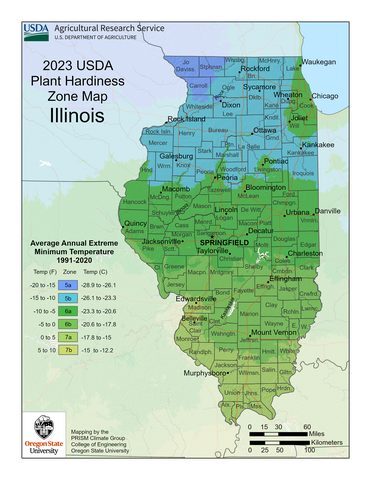The climate in Illinois is changing rapidly due to global climate shifts driven by human activities such as burning fossil fuels and deforestation. These changes are significantly impacting weather patterns, affecting our trees’ health and sustainability. Understanding these impacts is crucial for homeowners, arborists, and conservationists as they work to protect and manage our urban and rural forests.
Shifting Weather Patterns
Illinois is experiencing a shift toward wetter conditions, with an overall increase in precipitation. However, this increase is not in the form of gentle, steady rain but rather in intense, heavy downpours. Such deluges can lead to significant runoff, reducing water infiltrating the soil and increasing the risk of flooding and erosion. This shift in rainfall patterns can stress trees, making them more vulnerable to diseases and pests.
Additionally, warming temperatures have already caused a shift in the USDA hardiness zones for the Chicagoland region. The 2023 update reflects more moderate winter temperatures, which means that certain tree species that thrived in colder climates may struggle to adapt to these new conditions. Conversely, some species that prefer warmer climates may find Illinois more hospitable.

Impact on Tree Species
Different tree species have varying levels of adaptability to these new weather patterns. For instance, oaks and hickories, which dominate many Illinois forests, are projected to have fair to good capability in adapting to the changing climate. These species are resilient to some of the stressors brought about by climate change, such as increased temperatures and variable precipitation.
However, species like Acer saccharum (sugar maple), which compete in many oak-hickory stands, may not fare as well. These trees are sensitive to drought and changes in soil moisture, both of which are expected to become more common as climate change progresses. Similarly, mesic upland and bottomland forests, which include a diverse array of spices, will see a split between those that can adapt well and those that will struggle.

Temperature and Precipitation Changes
Since the beginning of the century, temperatures in Illinois have risen by approximately 1 degree Fahrenheit and are projected to increase by 4.5-9.5 degrees Fahrenheit by the late century. This warming affects the length of the growing season, the pressure from deer browsing, and the overall health and respiration rates of trees. It also increases the likelihood of summer droughts, which can further stress trees and make them more susceptible to pests and diseases.

Annual precipitation in Illinois has been above average since 1990, with winters and springs expected to become much wetter by mid-century. However, summer precipitation is projected to decline by 5-10% across central and southern parts of the state. These extreme rainfall events can lead to significant impacts on soil moisture, frozen ground duration, flooding, and surface runoff, all of which can affect tree health and survival.

Soil Moisture and Drought Stress
The changing precipitation patterns, combined with warmer conditions and longer growing seasons, will likely lead to increased drought stress for many trees. More frequent intense rain events will result in water being lost to runoff rather than being stored in the soil, further exacerbating drought conditions. Drought-stressed trees are more vulnerable to insect outbreaks and diseases, which can have devastating effects on forests.
There is some evidence that elevated carbon dioxide levels in the atmosphere may help some tree species withstand short-term drought stress. However, this potential benefit is unlikely to offset the broader negative impacts of climate change on tree health and survival.
Conclusion
The impacts of climate change on Illinois’ weather patterns and tree health are profound and far-reaching. While some tree species may adapt to the new conditions, others will struggle, making it essential for us to act now. By utilizing available resources and programs, we can mitigate these impacts and ensure the continued health of our trees and forests. Contact Homer Tree Care for expert guidance and support in managing your trees in this changing climate.

